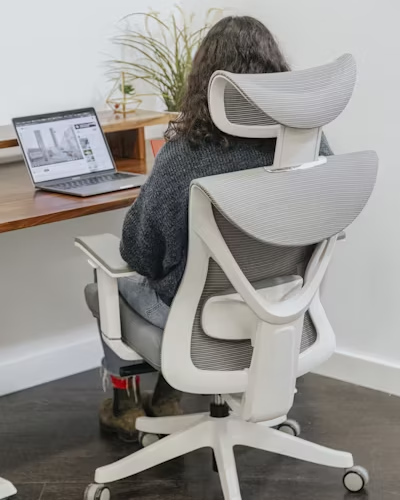The first few minutes in a chair are deceptive—comfort doesn’t always mean support. This is the moment most people make their decision, and it’s usually based on superficial cues: soft cushioning, sleek lines, or a persuasive product description filled with trendy buzzwords.
Many buyers focus on what they can immediately sense: plushness, texture, and visual appeal. They press down on the seat, test the recline a few times, and base the decision on whether the chair feels “good enough.” But comfort at rest is not the same as comfort in action. Some chairs feel luxurious for the first five minutes, only to trigger stiffness and discomfort by midday.
Certain features consistently mislead new buyers. Overly soft padding might seem appealing, but it compresses quickly and offers little support. Wide armrests feel generous but often lack adjustability, leading to awkward angles and poor posture. The “gaming chair” label is another red flag—it often prioritizes visual drama over ergonomic function, with exaggerated bolsters and rigid angles that restrict natural movement.
Instead, the first impression should focus on foundational features. The seat pan—the part of the chair you actually sit on—should allow your thighs to rest evenly, with about 2–3 fingers of space between the seat’s edge and the back of your knees. The height range should let your feet touch the floor while keeping your knees at a 90-degree angle. Lumbar support should engage your lower back even when you’re sitting casually—not just when you’re forcing a “proper” posture.
Chair Checkpoint #1: Five-Minute Sit Test
Before committing, pause and assess the following:
- Do your feet rest flat without strain or dangling?
- Does your lower back feel supported without effort?
- Is the seat too deep or too shallow for your thighs?
- Are your hips slightly higher than your knees?
- Can you adjust height and recline without leaving the chair?
A chair that passes this test has potential. But it hasn’t proven itself yet. That comes next.
How Chairs Affect Focus and Posture
Around hour two, your chair starts revealing what it’s made for. The novelty wears off. What remains is either a foundation for sustained concentration or a growing list of physical irritations.
Enter “Posture Creep.” You begin the day upright, alert. But over time, you shift. You lean forward. You hunch. You rest on one elbow. These micro-adjustments don’t feel significant at first, but they compound. They create stress points, muscle fatigue, and distractions that affect not just your back, but your brain.
A major factor is whether the chair supports dynamic ergonomics. This means it adapts with you. Can you lean back to stretch without disengaging from your work? Does the backrest offer resistance—or does it give way too easily? Tilt tension, for instance, lets you control how much effort is required to recline. If it’s too loose, you’ll avoid reclining. If it’s too stiff, you’ll stay frozen in one position.
Backrest recline is more than a luxury—it helps you shift your posture throughout the day. A good chair encourages movement, even subtle fidgeting. Similarly, adjustable armrests matter. Fixed arms trap you in a single posture, which sounds stabilizing but actually reduces circulation and invites shoulder tension. Look for armrests that move in height, width, and angle. Ideally, they should allow your forearms to rest with elbows at a 90-degree bend and shoulders relaxed.
Monitor height and desk surface also influence how your chair functions. If your monitor is too low, you’ll lean forward, no matter how good the chair is. If your desk is too tall, you’ll raise your arms awkwardly. A chair alone can’t fix bad desk ergonomics—but it should integrate well into your full setup.
Cognitive performance suffers from poor ergonomics. You may not notice it immediately, but constant micro-adjustments and discomfort create low-level fatigue. Your brain stays partially occupied with managing pain, restlessness, or repositioning, reducing your attention span and clarity.
Chair Checkpoint #2: Midday Evaluation
Around the 2–4 hour mark, ask yourself:
- Are you shifting constantly to get comfortable?
- Do you feel the need to get up more often than usual?
- Are you unconsciously leaning forward or resting on one arm?
- Do your shoulders feel tense, or are you shrugging?
- Is your lower back still supported, or has the lumbar shifted?
If you find yourself distracted or sore, the chair might be working against you. This is where most generic chairs fail—by not supporting real-life working patterns.
What Happens After Weeks, Not Hours
Good chairs don’t just feel good—they support habits, health, and discipline over time. You can fake good posture for a day. But after a few weeks, the consequences of a poor chair become harder to ignore.
Spinal health takes a slow hit from bad seating. Chairs that lack lumbar support promote a flattened lower back curve, leading to disc pressure and eventual pain. Similarly, pressure behind the knees from a poorly shaped seat can restrict circulation, leading to numbness or cold feet.
Materials matter, too—not just in comfort but in resilience. Low-quality foam flattens, synthetic leather cracks, and plastic joints start to creak or loosen. A good chair maintains its structure through months of daily use. You shouldn’t have to tighten bolts or reposition cushions constantly.
The edge contour of the seat—often overlooked—is critical. A hard or steep edge restricts leg movement and circulation. Look for waterfall edges: gently sloped fronts that reduce pressure. Breathable fabrics reduce sweat and skin irritation during long sitting sessions.
Advanced users often seek out 3D or 4D armrests—those that adjust not just up and down, but also slide forward, angle inward, and pivot. These aren’t just bells and whistles. They accommodate different tasks: typing, reading, video calls, or stretching.
Movement is key. The best chairs support task switching—leaning in, sitting back, crossing legs, pivoting slightly to reach something. Chairs that lock you into one rigid posture lead to mental and physical stagnation.
Chair Checkpoint #3: One-Month Review
After a few weeks of regular use, reflect on:
- Do you feel less back or neck pain than before?
- Are you adjusting the chair throughout the day—or avoiding it?
- Has the material retained shape and comfort?
- Do you feel more focused during long sessions?
- Does your posture look better in video calls or mirrors?
The long haul is where truly ergonomic chairs justify their cost. They don’t just support—they improve.
How the Wrong Chair Shows Up in Unexpected Places
The cost of a bad chair is often paid outside the chair. Back pain doesn’t only flare while sitting—it follows you into sleep, workouts, and even mood. The effects extend far beyond the office.
Frequent chiropractor visits, recurring wrist or shoulder pain, and even migraines can stem from a poor seating setup. The chain of strain often starts at the hips or spine and travels upward or outward. You may wake up sore and not realize it was yesterday’s posture that caused it.
Sleep issues sometimes connect directly to seated work. Slumped posture compresses the diaphragm and alters breathing. Muscular tension builds and makes it harder to relax at night.
There are psychological costs, too. Frustration builds over time. You dread sitting down, and even small tasks feel heavier. People unconsciously avoid their desks—preferring the couch, the bed, or even working while standing, not by choice but by desperation.
Employers and team leaders should care about this. In remote setups especially, where workers outfit their own spaces, ergonomics often get neglected. Poor chairs lead to decreased output, slower problem-solving, and higher burnout risk. One survey found that workers with supportive seating reported 17% higher self-rated productivity.
The budget argument comes up often. But the price of a better chair must be weighed against daily use. If you sit for eight hours a day, that’s 2,000 hours a year. A $500 chair breaks down to 25 cents per hour—a low cost for comfort, health, and performance.
Some workers even bring in restaurant furniture or dining chairs from home—an understandable but risky compromise. These chairs are not designed for task work, lack adjustability, and often place the body in non-neutral positions. A beautiful wooden chair may complement the decor, but it rarely supports eight hours of deep focus.
Customizing, Upgrading, and Making It Yours
Once you’ve found the right base, adjustability and customization make it ideal. No chair fits perfectly out of the box—not for everyone. But small additions make a big difference.
Cushions, memory foam seat pads, and lumbar rolls can tweak a chair to better match your spine or height. If your chair lacks foot support, a footrest or even a stable box can stabilize your posture. For hard floors, a mat reduces leg strain and prevents slipping.
Body size affects comfort more than many assume. Petite users often benefit from a shorter seat pan and closer lumbar curve. Taller users need longer backrests and higher armrests. Heavier users should prioritize weight ratings, base stability, and reinforced tilt mechanisms.
Accessories also matter. Headrests are useful for video calls or reading but unnecessary for intense typing. Caster wheels should match your flooring—hard wheels for carpet, soft for tile or wood. Even desk pairing is crucial: the wrong desk height can undo everything a good chair provides.
Customization doesn’t mean complication. It means knowing what your body needs and making small, reversible changes that make your daily work more sustainable.
You Sit How You Live
A chair is not just a tool—it reflects how you treat your time, body, and focus. It’s easy to overlook. It’s furniture, after all. But it touches your life for more hours than most things you own.
Think of a chair purchase as a decision that echoes through your week. Each feature you test today shapes your posture, mindset, and mood tomorrow. It’s not just about ergonomics—it’s about how you want to work and live.
Recap your checkpoints:
- First impression – short-term comfort is misleading.
- Midday test – real support shows over hours.
- Long-haul use – look for resilience and adaptability.
- Beyond the desk – effects show up in your health and habits.
- Personal tweaks – adjust until it fits your life.
Don’t treat your chair as a one-time buy. Revisit how you use it, how you feel in it, and whether it still serves you. Because just like how you sleep or eat, how you sit shapes how you live.




